AI-102 : Designing and Implementing a Microsoft Azure AI Solution : Part 01
-
DRAG DROP
You have 100 chatbots that each has its own Language Understanding model.
Frequently, you must add the same phrases to each model.
You need to programmatically update the Language Understanding models to include the new phrases.
How should you complete the code? To answer, drag the appropriate values to the correct targets. Each value may be used once, more than once, or not at all. You may need to drag the split bar between panes or scroll to view content.
NOTE: Each correct selection is worth one point.

AI-102 Part 01 Q01 001 Question 
AI-102 Part 01 Q01 001 Answer Explanation:
Box 1: AddPhraseListAsync
Example: Add phraselist featurevar phraselistId = await client.Features.AddPhraseListAsync(appId, versionId, new PhraselistCreateObject
{
EnabledForAllModels = false,
IsExchangeable = true,
Name = “QuantityPhraselist”,
Phrases = “few,more,extra”
});Box 2: PhraselistCreateObject
-
DRAG DROP
You plan to use a Language Understanding application named app1 that is deployed to a container.
App1 was developed by using a Language Understanding authoring resource named lu1.
App1 has the versions shown in the following table.

AI-102 Part 01 Q02 002 You need to create a container that uses the latest deployable version of app1.
Which three actions should you perform in sequence? To answer, move the appropriate actions from the list of actions to the answer area and arrange them in the correct order. (Choose three.)
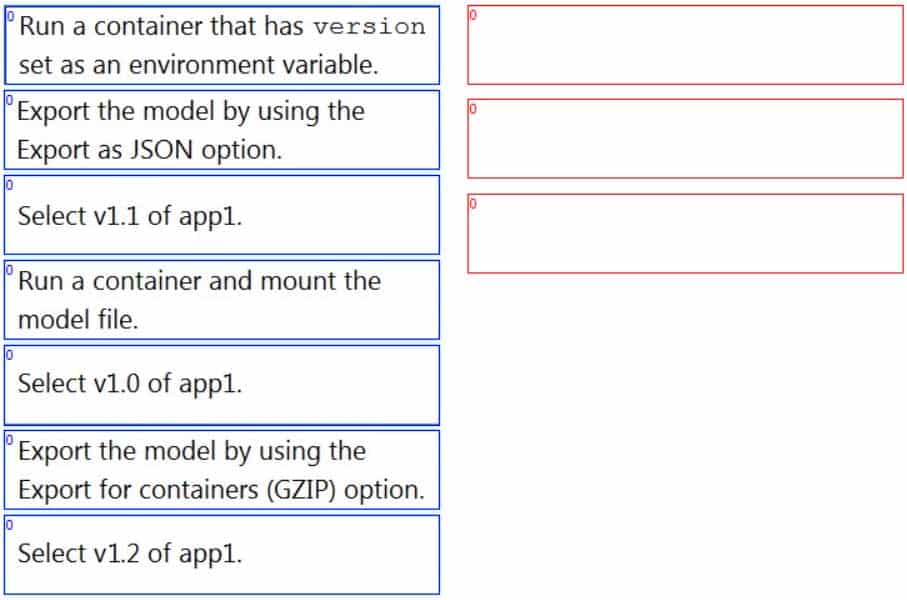
AI-102 Part 01 Q02 003 Question 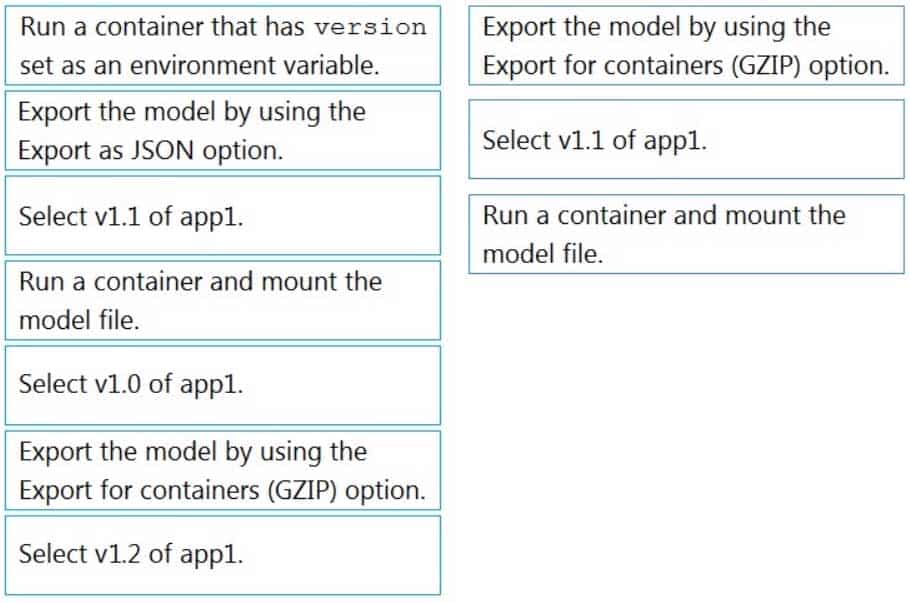
AI-102 Part 01 Q02 003 Answer Explanation:
Step 1: Export the model using the Export for containers (GZIP) option.
Export versioned app’s package from LUIS portal
The versioned app’s package is available from the Versions list page.
1. Sign on to the LUIS portal.
2. Select the app in the list.
3. Select Manage in the app’s navigation bar.
4. Select Versions in the left navigation bar.
5. Select the checkbox to the left of the version name in the list.
6. Select the Export item from the contextual toolbar above the list.
7. Select Export for container (GZIP).
8. The package is downloaded from the browser.
AI-102 Part 01 Q02 004 Step 2: Select v1.1 of app1.
A trained or published app packaged as a mounted input to the container with its associated App ID.Step 3: Run a contain and mount the model file.
Run the container, with the required input mount and billing settings. -
You need to build a chatbot that meets the following requirements:
– Supports chit-chat, knowledge base, and multilingual models
– Performs sentiment analysis on user messages
– Selects the best language model automaticallyWhat should you integrate into the chatbot?
- QnA Maker, Language Understanding, and Dispatch
- Translator, Speech, and Dispatch
- Language Understanding, Text Analytics, and QnA Maker
- Text Analytics, Translator, and Dispatch
Explanation:
Language Understanding: An AI service that allows users to interact with your applications, bots, and IoT devices by using natural language.QnA Maker is a cloud-based Natural Language Processing (NLP) service that allows you to create a natural conversational layer over your data. It is used to find the most appropriate answer for any input from your custom knowledge base (KB) of information.
Text Analytics: Mine insights in unstructured text using natural language processing (NLP)—no machine learning expertise required. Gain a deeper understanding of customer opinions with sentiment analysis. The Language Detection feature of the Azure Text Analytics REST API evaluates text input
Incorrect Answers:
A, B, D: Dispatch uses sample utterances for each of your bot’s different tasks (LUIS, QnA Maker, or custom), and builds a model that can be used to properly route your user’s request to the right task, even across multiple bots. -
Your company wants to reduce how long it takes for employees to log receipts in expense reports. All the receipts are in English.
You need to extract top-level information from the receipts, such as the vendor and the transaction total. The solution must minimize development effort.
Which Azure Cognitive Services service should you use?
- Custom Vision
- Personalizer
- Form Recognizer
- Computer Vision
Explanation:
Azure Form Recognizer is a cognitive service that lets you build automated data processing software using machine learning technology. Identify and extract text, key/value pairs, selection marks, tables, and structure from your documents—the service outputs structured data that includes the relationships in the original file, bounding boxes, confidence and more.Form Recognizer is composed of custom document processing models, prebuilt models for invoices, receipts, IDs and business cards, and the layout model.
-
HOTSPOT
You need to create a new resource that will be used to perform sentiment analysis and optical character recognition (OCR). The solution must meet the following requirements:
– Use a single key and endpoint to access multiple services.
– Consolidate billing for future services that you might use.
– Support the use of Computer Vision in the future.How should you complete the HTTP request to create the new resource? To answer, select the appropriate options in the answer area.
NOTE: Each correct selection is worth one point.
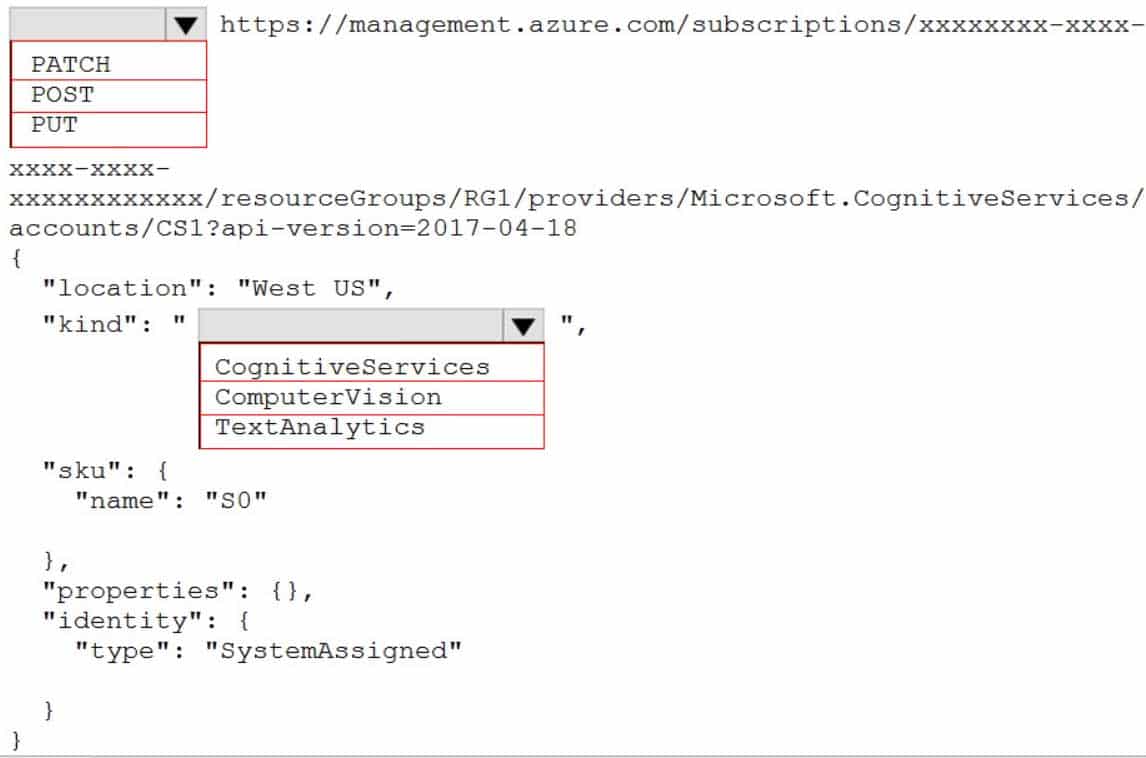
AI-102 Part 01 Q05 005 Question 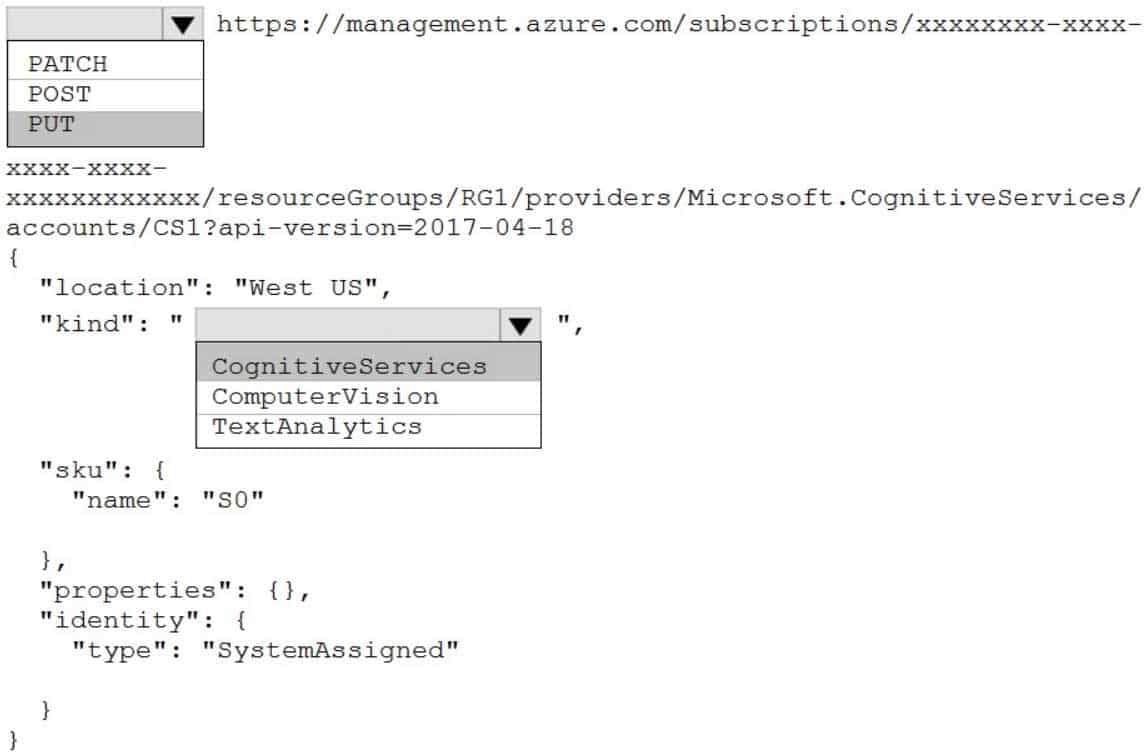
AI-102 Part 01 Q05 005 Answer Explanation:
Box 1: PUT
Sample Request: PUT https://management.azure.com/subscriptions/00000000-0000-0000-0000-000000000000/resourceGroups/test-rg/providers/Microsoft.DeviceUpdate/accounts/contoso?api-version=2020-03-01-previewIncorrect Answers:
PATCH is for updates.Box 2: CognitiveServices
Microsoft Azure Cognitive Services provide us to use its pre-trained models for various Business Problems related to Machine Learning.List of Different Services are:
– Decision
– Language (includes sentiment analysis)
– Speech
– Vision (includes OCR)
– Web Search -
You are developing a new sales system that will process the video and text from a public-facing website.
You plan to monitor the sales system to ensure that it provides equitable results regardless of the user’s location or background.
Which two responsible AI principles provide guidance to meet the monitoring requirements? Each correct answer presents part of the solution. (Choose two.)
NOTE: Each correct selection is worth one point.
- transparency
- fairness
- inclusiveness
- reliability and safety
- privacy and security
Explanation:AI systems should treat all people fairly.
AI systems should perform reliably and safely. -
DRAG DROP
You plan to use containerized versions of the Anomaly Detector API on local devices for testing and in on-premises datacenters.
You need to ensure that the containerized deployments meet the following requirements:
– Prevent billing and API information from being stored in the command-line histories of the devices that run the container.
– Control access to the container images by using Azure role-based access control (Azure RBAC).Which four actions should you perform in sequence? To answer, move the appropriate actions from the list of actions to the answer area and arrange them in the correct order. (Choose four.)
NOTE: More than one order of answer choices is correct. You will receive credit for any of the correct orders you select.

AI-102 Part 01 Q07 006 Question 
AI-102 Part 01 Q07 006 Answer Explanation:
Step 1: Pull the Anomaly Detector container image.
Step 2: Create a custom Dockerfile
Step 3: Push the image to an Azure container registry.
To push an image to an Azure Container registry, you must first have an image.Step 4: Distribute the docker run script
Use the docker run command to run the containers. -
HOTSPOT
You plan to deploy a containerized version of an Azure Cognitive Services service that will be used for text analysis.
You configure https://contoso.cognitiveservices.azure.com as the endpoint URI for the service, and you pull the latest version of the Text Analytics Sentiment Analysis container.
You need to run the container on an Azure virtual machine by using Docker.
How should you complete the command? To answer, select the appropriate options in the answer area.
NOTE: Each correct selection is worth one point.
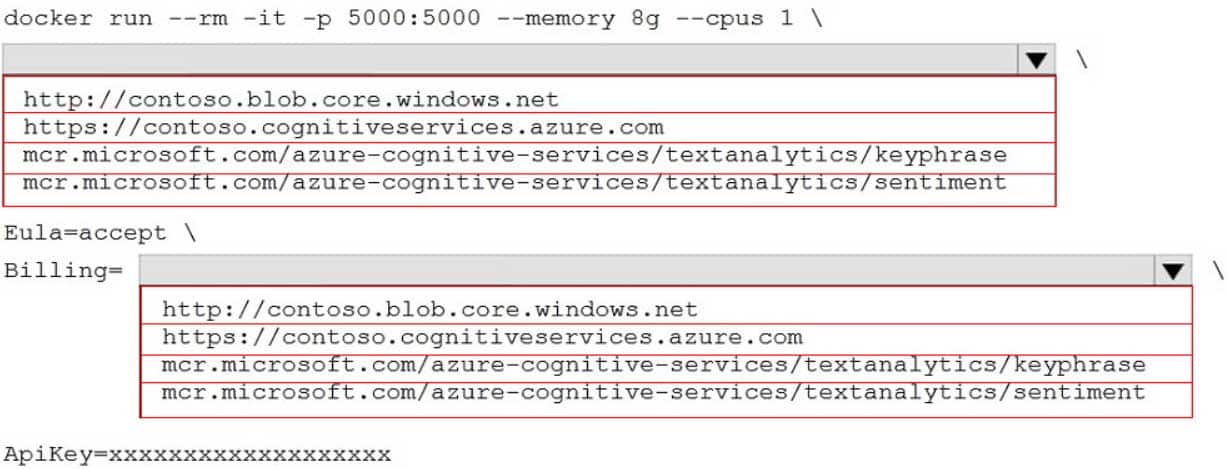
AI-102 Part 01 Q08 007 Question 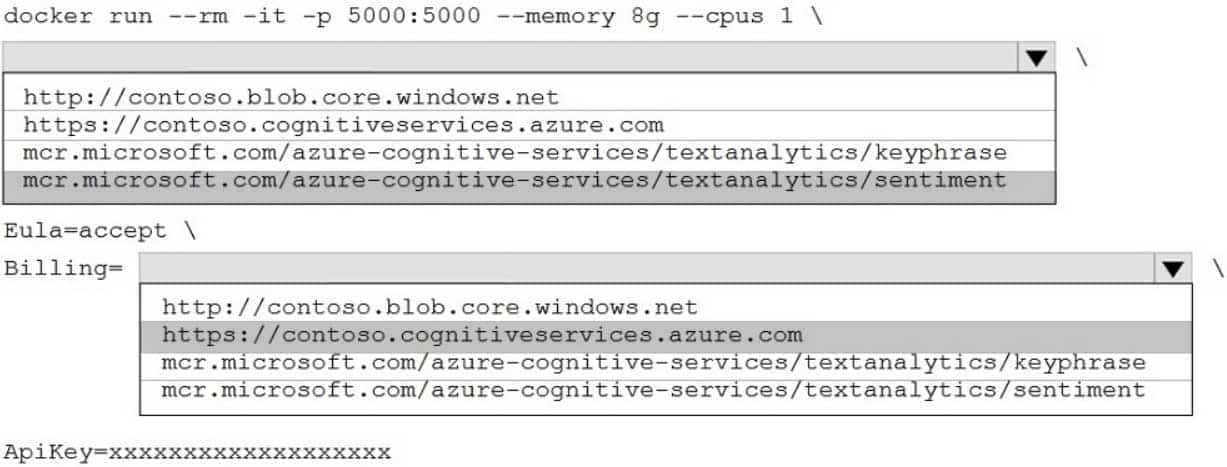
AI-102 Part 01 Q08 007 Answer Explanation:
Box 1: mcr.microsoft.com/azure-cognitive-services/textanalytics/sentiment
To run the Sentiment Analysis v3 container, execute the following docker run command.
docker run –rm -it -p 5000:5000 –memory 8g –cpus 1 \
mcr.microsoft.com/azure-cognitive-services/textanalytics/sentiment \
Eula=accept \
Billing={ENDPOINT_URI} \
ApiKey={API_KEY} is the endpoint for accessing the Text Analytics API. https://<your-custom-subdomain>.cognitiveservices.azure.comBox 2: https://contoso.cognitiveservices.azure.com
{ENDPOINT_URI} is the endpoint for accessing the Text Analytics API: https://<your-custom-subdomain>.cognitiveservices.a The endpoint for accessing the Text Analytics API. zure.com -
You have the following C# method for creating Azure Cognitive Services resources programmatically.

AI-102 Part 01 Q09 008 You need to call the method to create a free Azure resource in the West US Azure region. The resource will be used to generate captions of images automatically.
Which code should you use?
-
create_resource(client, "res1", "ComputerVision", "F0", "westus")
-
create_resource(client, "res1", "CustomVision.Prediction", "F0", "westus") -
create_resource(client, "res1", "ComputerVision", "S0", "westus")
-
create_resource(client, "res1", "CustomVision.Prediction", "S0", "westus")
Explanation:
Many of the Cognitive Services have a free tier you can use to try the service. To use the free tier, use F0 as the SKU for your resource.
There are two tiers of keys for the Custom Vision service. You can sign up for a F0 (free) or S0 (standard) subscription through the Azure portal.Incorrect Answers:
A: There is no free tier (F0) for ComputerVision. -
-
You successfully run the following HTTP request.
POST https://management.azure.com/subscriptions/18c51a87-3a69-47a8-aedc-a54745f708a1/resourceGroups/RG1/providers/Microsoft.CognitiveServices/accounts/contosol/regenerateKey?api-version=2017-04-18 Body{"keyName": "Key2"}What is the result of the request?
- A key for Azure Cognitive Services was generated in Azure Key Vault.
- A new query key was generated.
- The primary subscription key and the secondary subscription key were rotated.
- The secondary subscription key was reset.
Explanation:
Accounts – Regenerate Key regenerates the specified account key for the specified Cognitive Services account.Syntax:
POST https://management.azure.com/subscriptions/{subscriptionId}/resourceGroups/{resourceGroupName}/providers/Microsoft.CognitiveServices/accounts/{accountName}/regenerateKey?api-version=2017-04-18 -
You build a custom Form Recognizer model.
You receive sample files to use for training the model as shown in the following table.
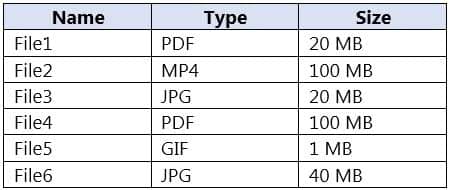
AI-102 Part 01 Q11 009 Which three files can you use to train the model? Each correct answer presents a complete solution. (Choose three.)
NOTE: Each correct selection is worth one point.
- File1
- File2
- File3
- File4
- File5
- File6
Explanation:
Input requirements
Form Recognizer works on input documents that meet these requirements:Format must be JPG, PNG, PDF (text or scanned), or TIFF. Text-embedded PDFs are best because there’s no possibility of error in character extraction and location.
File size must be less than 50 MB -
A customer uses Azure Cognitive Search.
The customer plans to enable a server-side encryption and use customer-managed keys (CMK) stored in Azure.
What are three implications of the planned change? Each correct answer presents a complete solution.
NOTE: Each correct selection is worth one point.
- The index size will increase.
- Query times will increase.
- A self-signed X.509 certificate is required.
- The index size will decrease.
- Query times will decrease.
- Azure Key Vault is required.
-
You are developing a new sales system that will process the video and text from a public-facing website.
You plan to notify users that their data has been processed by the sales system.
Which responsible AI principle does this help meet?
- transparency
- fairness
- inclusiveness
- reliability and safety
-
Note: This question is part of a series of questions that present the same scenario. Each question in the series contains a unique solution that might meet the stated goals. Some question sets might have more than one correct solution, while others might not have a correct solution.
After you answer a question in this section, you will NOT be able to return to it. As a result, these questions will not appear in the review screen.
You create a web app named app1 that runs on an Azure virtual machine named vm1. Vm1 is on an Azure virtual network named vnet1.
You plan to create a new Azure Cognitive Search service named service1.
You need to ensure that app1 can connect directly to service1 without routing traffic over the public internet.
Solution: You deploy service1 and a public endpoint to a new virtual network, and you configure Azure Private Link.
Does this meet the goal?
- Yes
- No
-
Note: This question is part of a series of questions that present the same scenario. Each question in the series contains a unique solution that might meet the stated goals. Some question sets might have more than one correct solution, while others might not have a correct solution.
After you answer a question in this section, you will NOT be able to return to it. As a result, these questions will not appear in the review screen.
You create a web app named app1 that runs on an Azure virtual machine named vm1. Vm1 is on an Azure virtual network named vnet1.
You plan to create a new Azure Cognitive Search service named service1.
You need to ensure that app1 can connect directly to service1 without routing traffic over the public internet.
Solution: You deploy service1 and a public endpoint, and you configure an IP firewall rule.
Does this meet the goal?
- Yes
- No
-
Note: This question is part of a series of questions that present the same scenario. Each question in the series contains a unique solution that might meet the stated goals. Some question sets might have more than one correct solution, while others might not have a correct solution.
After you answer a question in this section, you will NOT be able to return to it. As a result, these questions will not appear in the review screen.
You create a web app named app1 that runs on an Azure virtual machine named vm1. Vm1 is on an Azure virtual network named vnet1.
You plan to create a new Azure Cognitive Search service named service1.
You need to ensure that app1 can connect directly to service1 without routing traffic over the public internet.
Solution: You deploy service1 and a public endpoint, and you configure a network security group (NSG) for vnet1.
Does this meet the goal?
- Yes
- No
-
You plan to perform predictive maintenance.
You collect IoT sensor data from 100 industrial machines for a year. Each machine has 50 different sensors that generate data at one-minute intervals. In total, you have 5,000 time series datasets.
You need to identify unusual values in each time series to help predict machinery failures.
Which Azure Cognitive Services service should you use?
- Anomaly Detector
- Cognitive Search
- Form Recognizer
- Custom Vision
-
HOTSPOT
You are developing a streaming Speech to Text solution that will use the Speech SDK and MP3 encoding.
You need to develop a method to convert speech to text for streaming MP3 data.
How should you complete the code? To answer, select the appropriate options in the answer area.
NOTE: Each correct selection is worth one point.
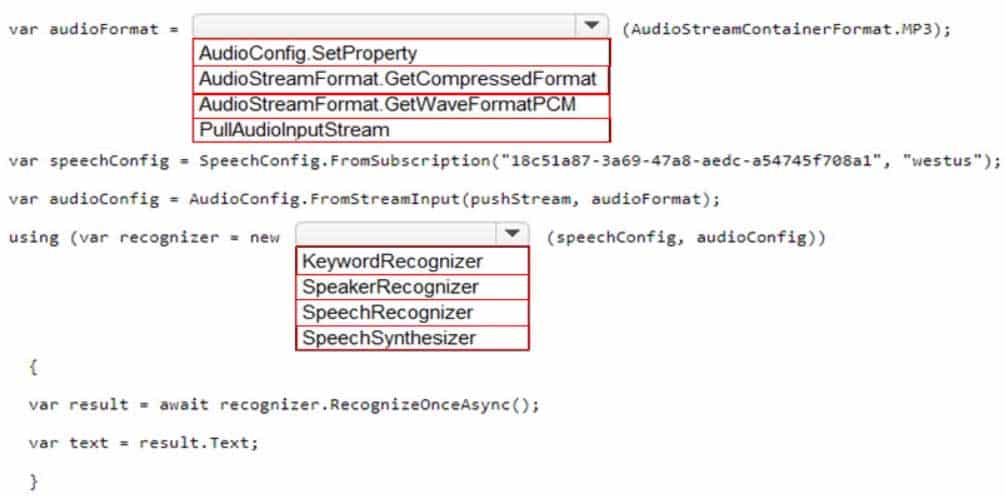
AI-102 Part 01 Q18 010 Question 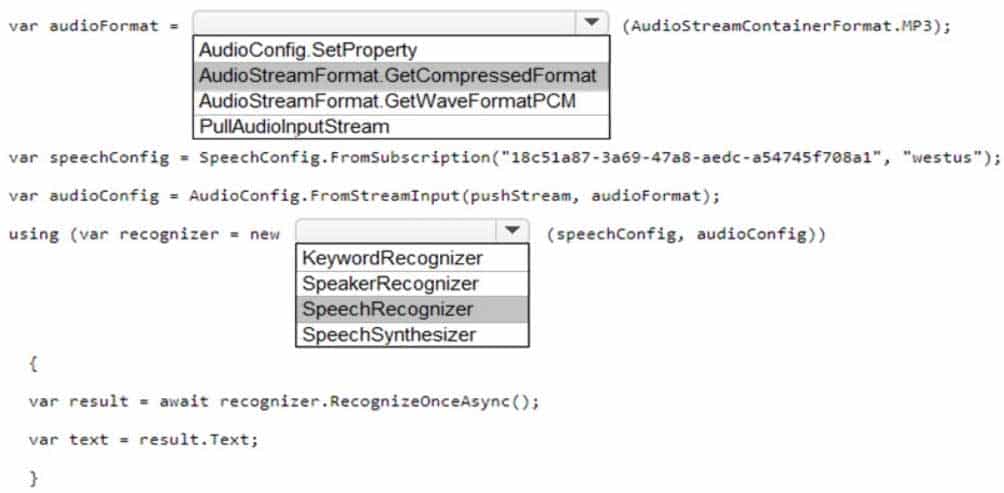
AI-102 Part 01 Q18 010 Answer -
HOTSPOT
You are developing an internet-based training solution for remote learners.
Your company identifies that during the training, some learners leave their desk for long periods or become distracted.
You need to use a video and audio feed from each learner’s computer to detect whether the learner is present and paying attention. The solution must minimize development effort and identify each learner.
Which Azure Cognitive Services service should you use for each requirement? To answer, select the appropriate options in the answer area.
NOTE: Each correct selection is worth one point.
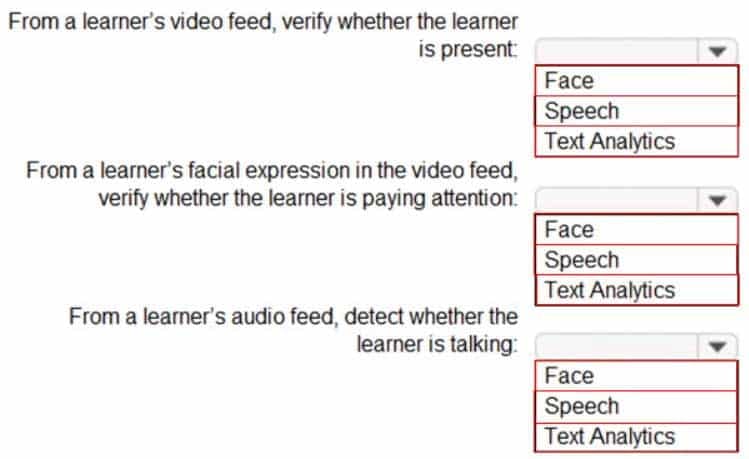
AI-102 Part 01 Q19 011 Question 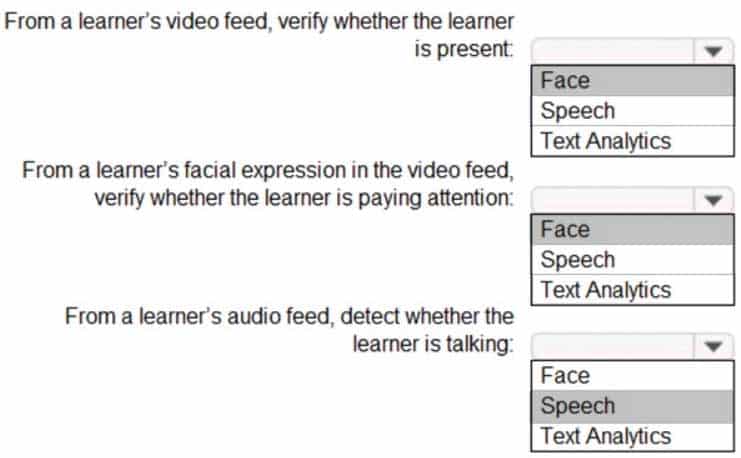
AI-102 Part 01 Q19 011 Answer -
You plan to provision a QnA Maker service in a new resource group named RG1.
In RG1, you create an App Service plan named AP1.
Which two Azure resources are automatically created in RG1 when you provision the QnA Maker service? Each correct answer presents part of the solution.
NOTE: Each correct selection is worth one point.
- Language Understanding
- Azure SQL Database
- Azure Storage
- Azure Cognitive Search
- Azure App Service